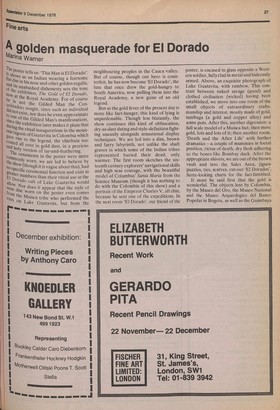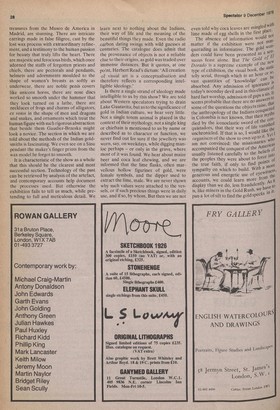A golden masquerade for El Dorado
Marina Warner
II he Poster tells us: 'This Man is El Dorado'. I shows us an Indian wearing a fearsome flat disc in his nose and other golden regalia. and its unabashed dishonesty sets the tone of the exhibition, The Gold of El Dorado, now at the Royal Academy. For of course he is not the Gilded Man the Conquistadors sought, since such an individual did not exist, nor does he even approximate tc.) one of the Gilded Man's manifestations, s_,ince the exhibition later makes it plain that tiring the ritual inaugurations in the mountain lagoon of Guatavita in Colombia which gave rise to the legend, the chieftain was coated all over in gold dust, in a precious and holy version of tar-and-feathering. The ornaments in the poster were more cth°111°Innly worn, we are led to believe by "e show (though it is vague about this), had n° sPecific ceremonial function and exist in greater numbers than their ritual use in the Dorado cult of Lake Guatavita would antl°w. Nor does it appear that the style of 2se disc worn on the poster even comes 4.0rn. the Muisca tribe who performed the rites on neighbouring peoples in the Cauca valley. But of course, though our hero is counterfeit, he has now become 'El Dorado', the lure that once drew the gold-hungry to South America, now pulling them into the Royal Academy, a new guise of an old legend. But as the gold fever of the present day is more like fact-hunger, this kind of lying is unpardonable. Though less blatantly, the show continues this kind of obfuscation, dry-as-dust dating and style-definition fighting uneasily alongside sensational display techniques. We are led into a dim, brown and fnrry labyrinth, not unlike the shaft graves in which some of the Indian tribes represented buried their dead, only warmer. The first room sketches the sixteenth century explorers' navigational skills and high seas courage, with the beautiful model of Columbus' Santa Maria from the Science Museum (though it has nothing to do with the Colombia of this show) and a portrait of the Emperor Charles V, all chin, because he sent one of the expeditions. In the next room 'El Dorado', our friend of the poster, is encased in glass opposite a Western soldier, fully clad in metal and hideously armed. Above, an exquisite photograph of Lake Guatavita, with rainbow. This contrast between naked savage (good) and clothed civilisation (wicked) having been established, we move into one room of the small objects of extraordinary craftsmanship and interest, mostly made of gold, tumbaga (a gold and copper alloy) and some pots. After this, another digression: a full scale model of a Muisca hut; then more gold, lots and lots of it; then another room, 'Death and the After Life' with further dramatics — a couple of mummies in foetal position, rictus of death, dry flesh adhering to the bones like Bombay duck. After the appropriate shivers, we are out of the brown vault and into the Sales Area, jigsaw puzzles, ties, scarves, cut-out 'El Dorados', fierce-looking charts for the fact-famished.
It must be said first that the gold is wonderful. The objects lent by Colombia, by the Museo del Oro, the Museo National and the Museo Arqueologico del Banco Popolar in Bogota, as well as the Quirnbaya treasures from the Museo de America in Madrid, are stunning. There are intricate earrings made in false filigree, cast by the lost wax process with extraordinary refinement, and a testimony to the human passion for beauty that truly lifts the heart. There are majestic and ferocious birds, which once adorned the staffs of forgotten priests and chiefs, there are pectorals and pendants, helmets and adornments moulded to the shape of women's breasts as softly as , underwear, there are noble penis covers like unicorn horns, there are nose discs worked so smooth under the hammer that they look turned on a lathe, there are necklaces of frogs and charms of alligators, ex vows in the shape of men and dragons and snakes, and ornaments which treat the human figure with such rigorous abstraction that beside them Gaudier-Brzeska might look a novice. The section in which we are told about the methods of the Indian goldsmiths is fascinating. We even see on a Sinu pendant the maker's finger prints from the wax model he forgot to smooth.
It is characteristic of the show as a whole that this should be the clearest and most successful section. Technology of the past can be retrieved by analysis of the artefact, and contemporary accounts help document the processes used. But otherwise the exhibition fails to tell us much, while pretending to full and meticulous detail. We learn next to nothing about the Indians, their way of life and the meaning of the beautiful things they made. Even the radio carbon dating swings with wild guesses at centuries. The catalogue does admit that the provenance of objects is not a reliable clue to their origins, as gold was traded over immense distances. But it quotes, at one point, Herbert Read's dictum: 'All creation of visual art is a conceptualisation and therefore reflects a corresponding intelligible ideology.'
Is there a single strand of ideology made intelligible to us by this show? We are told about Western speculators trying to drain Lake Guatavita, but as to the significance of gold in Indian culture, we hear very little. Not a single totem animal is placed in the context of their mythology, not a single king or chieftain is mentioned to us by name or described as to character or function, we never find out for sure if the jewellery was worn, say, on weekdays, while digging manioc perhaps or only in the grave, where most of it was found. We hear about maize beer and coca leaf chewing, and we are informed that the lime flasks, often marvellous hollow figurines of gold, were female symbols, and the dipper used to extract the lime, male. We are never shpwn why such values were attached to the vessels, or if such precious things were in daily use, and if so, by whom. But then we are not Spectator 9 December 1978 even told why coca leaves are mingled with lime made of egg shells in the first place. The absence of information would not matter if the exhibition were not Inasquerading as informative. The gold wollders could have been presented as a sea; suous feast alone. But The Gold of Et Dorado is a supreme example of the new type of exhibition, the visual book, the static telly serial, through which in an hour or so, vast quantities of 'knowledge' earl be absorbed. Any admission of ignorance is, today's noonday devil and in this climate ot hard fact worship, admission of gaps a sin. It seems probable that there are no answers te some of the questions the objects raise, that the anthropology of the Indians in Colombia is not known, that their mYths conquereu died by the iconoclastic sword of the Cella quistadors, that their way of life vanished unchronicled. If that is so, I would like the organisers of the show to own up to it. yet ,. am not convinced: the missionaries who accompanied the conquest of the Americasf usually listened carefully to the beliefs of the peoples they were about to force int°, the true faith, if only to find points .sympathy on which to build. With a more generous and energetic use of eyewitness' accounts, we could learn more front th?, is, like miners in the Gold Rush, display than we do, less fraudulently. M we have to ot .011•0111.1111. pan a lot of silt to find the gold specks in It•















































 Previous page
Previous page